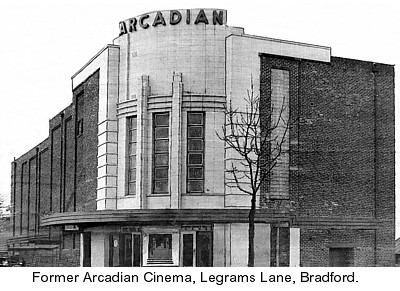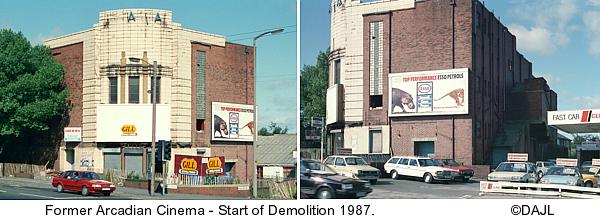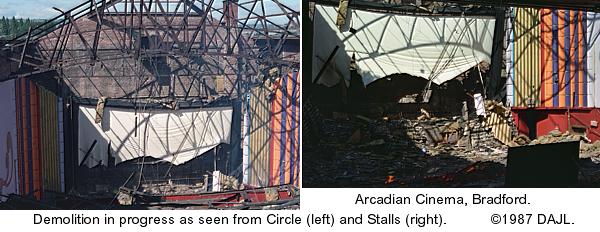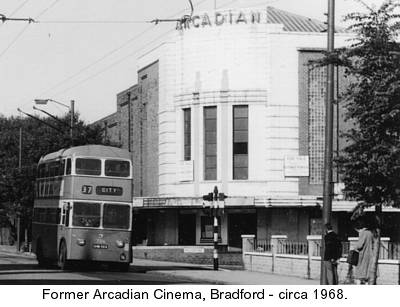|
Arcadian Cinema Legrams Lane/Ingleby Road, Lidget Green, Bradford.

Quick links to other sections on this page . . .
Theatrical Site History The Arcadian Pavilion closed during the period of the First World War (1914-1918) and then purchased by Ernest Binns in partnership with J.W Bilbrough and with Tom Holmes as manager they re-opened in 1919 with his "Merry Arcadians" Concert Party until the week commencing Monday 18th October 1920 when Binns presented his final performances before taking his concert party to a new residency in Morecambe (aka "Bradford-by-the-Sea") to delight holidaymakers there for another three decades. Many prominent figures of the variety stage and early screen appeared at the Arcadian Pavilion, most notably Max Miller, Sydney Howard and Milton Hayes. Maude Evans Silhouettes Company was the last to appear in 1930. In 1931 the wooden structure was badly damaged by fire and remained in ruins for eight years until demolished and the site cleared for building a new cinema. Meanwhile, Ernest Binns and his now named 'Arcadian Follies' were not forgotten by Bradford people who continued to flock to Morecambe. On completion of their summer season the Arcadian Follies would return to Bradford for a week at the Elite Picture House in Toller Lane which had excellent stage facilities. The original Arcadian Pavilion was one of five dotted around Bradford; these being the Alfresco Pavilion at Frizinghall which was preceded by the Frizinghall Pavilion behind the old Turf Hotel, Shipley Pavilion in Bradford Road (later to become the Prince's Hall cinema on the same site) and Undercliffe Pavilion in Northcote Road. New Super-Cinema Recognising the long theatrical history of this site, Hyde wisely named his new magnificent edifice Arcadian and was to incorporate all the latest trappings and equipment expected by cinemagoers. It is important to note that the Arcadian was the last new cinema to be built in the Bradford area and it it would be 30 years to 1969 before another new cinema (the twin Cinecentre/Penthouse) was to be built in the city centre. The Building The light, airy foyer situated on the left corner of the building was decorated in cream shading to amber and relieved with delicate tints of pink and green. This motif was continued in the inner foyer which was in the form of a cross-over corridor (behind the auditorium) from which two sets of double doors opened into the rear stalls where seating was in three blocks with two aisles; there was no interior cross-over other than in front of the stage between the two front-side exits. Access to the circle from the foyer was via stairs leading to the first floor circle foyer in a building void under the rear balcony. Here there were toilets and a feature fish tank and a small sitting Buddha statue - there was one in all of A.S Hyde's cinemas. Entry into the circle was via two vomitory-style entrances at each side of the circle with connecting cross-aisle. Seating in front and rear circle was in three block with two stepped aisles.
The lofty auditorium with barrel-vaulted ceiling and stylish pendant light fittings. A feature was the fluted splay walls and proscenium arch relieved in pastel shades of gold, green and mauve, banded in silver with curtains to tone. The splay walls had the added luxury of concealed lighting and special effects. 
The proscenium at 38 feet wide opened to a stage 15 feet deep with two dressing rooms. The screen was set at the back of the stage with screen tabs and house tabs, footlights and top battens. (As a matter if interest, the proscenium opening and stage size were the same as the new Ritz cinema in the city centre.) A large brick-built extension at the rear of the stage provided additional space for the loudspeaker system behind the screen. The new Arcadian seated 1,000 people with 680 in the stalls and 320 in the balcony in luxurious tip-up chairs. Council licensing records actually indicate 999 total seats. Wartime Blackout Latest Equipment "A fire extinguishing apparatus on the two projectors which is so efficient that if the film caught fire, the flames would be automatically extinguished"- a most desirable feature in those days of highly flammable nitrate film stock. The Arcadian also boasted . . . "an uncanny new American device which produces an amazing variety of spectacular lighting effects - there are only about a dozen of these machines in the whole country".A local man, Harry Moss, was contractor for the electrical work. The Opening The audience then enjoyed the feature film . . . "The Spy in Black" - 1939 UK B/W 82 mins.The same film then opened to the public on the following Monday 18th March 1940 with prices of 6d and 9d in the stalls and 1/- for the balcony. Coincidentally, at the Bradford Alhambra Theatre during the same week were the "Arcadian Follies" headed by Harry Korris - another Morecambe (and Bradford) favourite comedian. Meanwhile the Arcadian Cinema continued up to Easter 1940 with . . . "Les Miserables" - 1935 USA B/W 108 mins.with a special one-off showing on Good Friday of . . . "Elephant Boy" - 1937 UK B/W 80 mins. Boom Times Following successful conversions at his other cinemas, Shack Hyde installed a much bigger panoramic curved screen and from Monday 4th January 1954 the Arcadian boasted the new "Wide Dimension Screen" offering a larger and more impressive picture. This was adapted for CinemaScope in 1955. The Arcadian super-cinema was living up to its name and continued to be the premier cinema in the district completely outshining the nearby and much older Empress and Elysian picture houses and eventually outliving them. Quiet Closure "Jason and the Argonauts" - 1963 USA/UK Eastmancolor 104 mins. Shack Hyde said "There are no special farewell plans for the closure of the Arcadian. It will fold up and steal quietly away". An Afterlife In October 1970 it reverted back to being a cinema when it opened as the Commonwealth Film Club. In 1979 the T&A (7 Feb 1979) conducted a survey of conditions in the city's four Asian cinemas (Majestic, Liberty, Sangeet and Arcadian) and the Arcadian came out best for heating levels and maintenance of cinema and was "of a fairly high decorative standard" together with "toilet paper and soap is available from the pay box". Heat insulation plans were in hand at that time. All this adding to the increasing running costs. In 1986 the Arcadian building was put up for sale by Eddisons for £65,000 and after a year on the market it was eventually sold for re-development.   The building was demolished in 1987 and the site is now a tyre/exhaust and motor spares garage. May not be copied or reproduced without permission.
|
 Following the closure plans were submitted to the Council to convert the building into a night club but after an inquiry permission was refused. Asian films were shown for a while then the premises re-opened as the Arcadian Bingo Club.
Following the closure plans were submitted to the Council to convert the building into a night club but after an inquiry permission was refused. Asian films were shown for a while then the premises re-opened as the Arcadian Bingo Club.